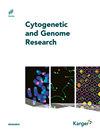17种鸟类种系限制性染色体和常染色体变异的Pachytene核型分析
IF 1.7
4区 生物学
Q4 CELL BIOLOGY
引用次数: 2
摘要
已知的鸟类核型不到10%。利用联会复合体、粗线期减数分裂染色体的核心结构和着丝粒蛋白的免疫定位,我们描述了17种鸟类的雄性粗线期核型。这种方法能够实现比中期染色体的传统分析更高的分辨率。我们提供了3种(麋鹿、布莱斯苇莺和欧洲花莺)的核型的首次描述,更正了10种已发表的核型数据,并确认了4种。所有检查的雀形目物种都具有高度保守的核型,2n=80-82,有7对大染色体(包括在大多数物种中与其他大染色体没有明确区别的ZZ性染色体对)和33-34对微染色体。在所有这些杜鹃中,但在普通杜鹃中没有,我们发现种系限制性染色体的单个拷贝在大小和形态上各不相同,即使在亲缘关系密切的物种之间也是如此。这表明这个额外的染色体进化很快。种间差异涉及大染色体的大小、微染色体的形态和着丝粒的大小。古尔迪燕雀、brambling和普通linnet的粗线期细胞含有异形联会复合体,表明反转或着丝粒移位的杂合性。欧洲的花蝇、古尔丹雀和家养金丝雀在几个宏观和微观染色体中都有延伸的着丝粒。本文章由计算机程序翻译,如有差异,请以英文原文为准。
Germline-Restricted Chromosomes and Autosomal Variants Revealed by Pachytene Karyotyping of 17 Avian Species
Karyotypes of less than 10% of bird species are known. Using immunolocalization of the synaptonemal complex, the core structure of meiotic chromosomes at the pachytene stage, and centromere proteins, we describe male pachytene karyotypes of 17 species of birds. This method enables higher resolution than the conventional analyses of metaphase chromosomes. We provide the first descriptions of the karyotypes of 3 species (rook, Blyth’s reed warbler, and European pied flycatcher), correct the published data on the karyotypes of 10 species, and confirm them for 4 species. All passerine species examined have highly conservative karyotypes, 2n = 80–82 with 7 pairs of macrochromosomes (including the ZZ sex chromosome pair which was not unambiguously distinguished from other macrochromosomes in most species) and 33–34 pairs of microchromosomes. In all of them, but not in the common cuckoo, we revealed single copies of the germline-restricted chromosomes varying in size and morphology even between closely related species. This indicates a fast evolution of this additional chromosome. The interspecies differences concern the sizes of the macrochromosomes, morphology of the microchromosomes, and sizes of the centromeres. The pachytene cells of the gouldian finch, brambling, and common linnet contain heteromorphic synaptonemal complexes indicating heterozygosity for inversions or centromere shifts. The European pied flycatcher, gouldian finch, and domestic canary have extended centromeres in several macro- and microchromosomes.
求助全文
通过发布文献求助,成功后即可免费获取论文全文。
去求助
来源期刊

Cytogenetic and Genome Research
生物-细胞生物学
CiteScore
3.10
自引率
5.90%
发文量
25
审稿时长
1 months
期刊介绍:
During the last decades, ''Cytogenetic and Genome Research'' has been the leading forum for original reports and reviews in human and animal cytogenetics, including molecular, clinical and comparative cytogenetics. In recent years, most of its papers have centered on genome research, including gene cloning and sequencing, gene mapping, gene regulation and expression, cancer genetics, comparative genetics, gene linkage and related areas. The journal also publishes key papers on chromosome aberrations in somatic, meiotic and malignant cells. Its scope has expanded to include studies on invertebrate and plant cytogenetics and genomics. Also featured are the vast majority of the reports of the International Workshops on Human Chromosome Mapping, the reports of international human and animal chromosome nomenclature committees, and proceedings of the American and European cytogenetic conferences and other events. In addition to regular issues, the journal has been publishing since 2002 a series of topical issues on a broad variety of themes from cytogenetic and genome research.
 求助内容:
求助内容: 应助结果提醒方式:
应助结果提醒方式:


